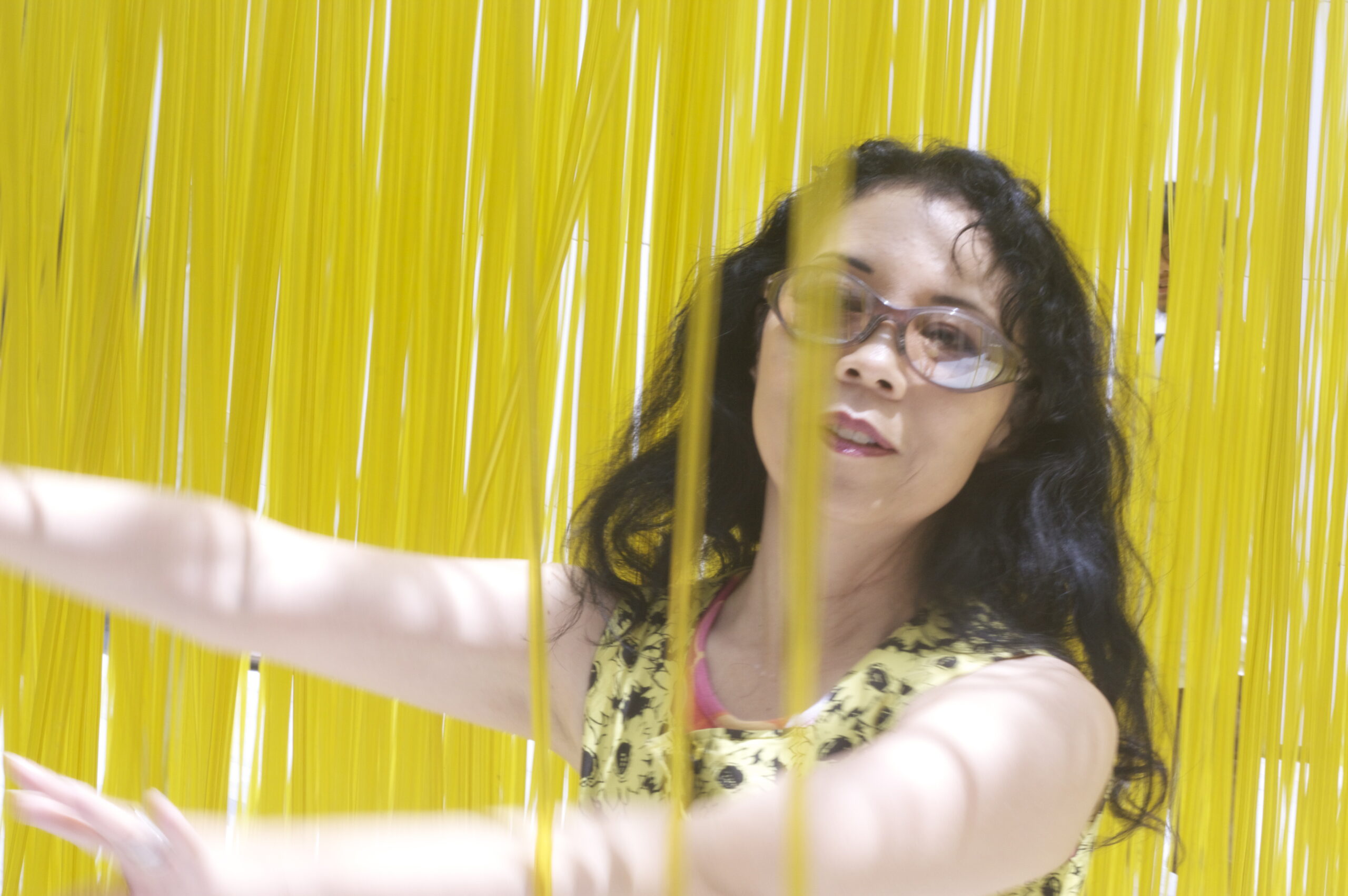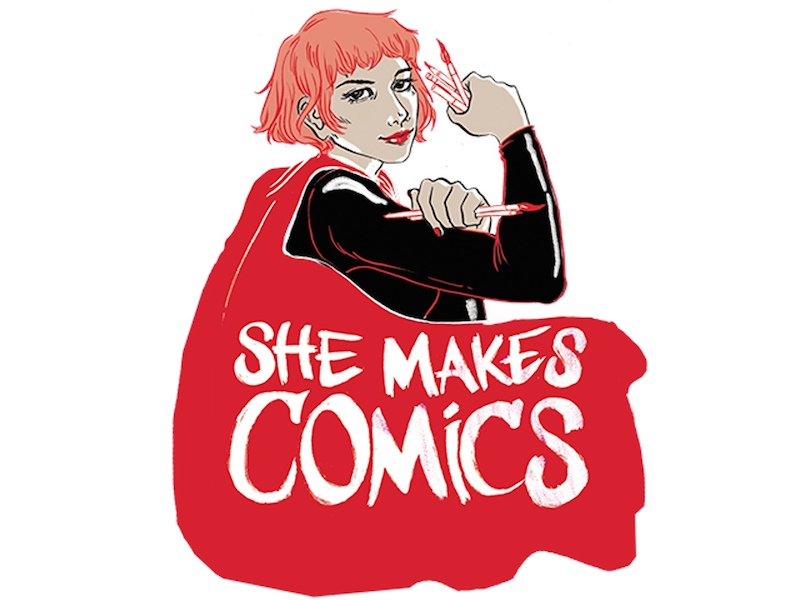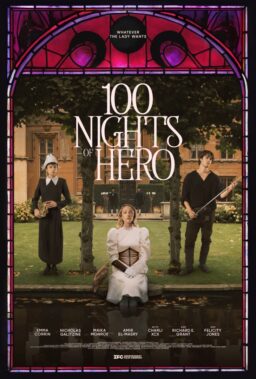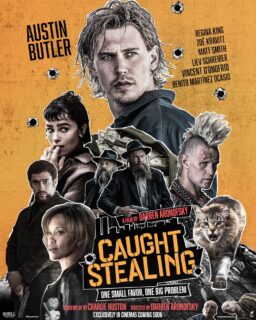There’s no doubt that women need a little bit of RESPECT, especially in comics and at Comic-Cons. Make time for the documentary “She Makes Comics,” a Kickstarter-funded independent documentary that won Best Documentary as part of the Comic-Con International Independent Film Festival at SDCC 2015. Although at times repetitive, the documentary highlights include interviews with Trina Robbins and Wendy Pini and a history on women in comics.
First-time director Marisa Stotter begins with a historical tour to let us know comics and comic books weren’t always male-dominated as is often thought. Comics historians Trina Robbins and Nancy Goldstein both remind us of the time that comics commanded respect in newspapers. They took up several pages. The whole family anticipated the adventures of their favorite heroes and heroines and read newspapers on a daily basis.
Robbins notes that at the turn of 20th century, a lot of women were involved in writing and drawing comics, “some were nationally famous.” Those female-centric comics “were the chick flicks of their day.” Comics were open to all races. The African-American woman, Jackie Ormes (1911-1985) created the “Torchy Brown in Dixie to Harlem” which eventually became “Torchy in Heartbeats.”
During World War II, with so many men in the army, a lot of women were making comics and they made them with “strong, competent, beautiful heroines.” Besides Wonder Woman, there were detectives, journalists and other “strong women who didn’t need to be rescued by guys.”
According to Janelle Asselin, comic book editor, at the time, the female readership for comics was 55 percent.
How did that change? According to “She Makes Comics,” the change can be traced back to the regulation of comic books. The Comics Code Authority (formed in 1954), which regulated kissing scenes and subject matter, resulted in comics being sanitized and that’s when superheroes became the main genre of the comic books.
Graphic novel librarian at Columbia University, Karen Green, notes, however, that “women in comics did not decline.”
There were women making comics and not just for women. Ramona Fradon wrote Aquaman and Brenda Starr and co-created the Aquaman villain Metamorpho. Born in 1926, this feisty woman is still alive at 88 and is one of the interviews featured. “Brenda Starr, Reporter” was actually created by Dale Messick for the Chicago Tribune in 1940 and Fradon illustrated “Brenda Starr” from 1980 until Fradon retired in 1995 (“Brenda Starr” was retired in 2011).
By the 1970s, romance comics lost popularity because the documentary indicates the consumer had changed but the stories had not. Robbins said that most romance comics were based on the sentiment that a woman could “only find true happiness if you meet the right man and get married and settle down and have a family.” With the women’s liberations movement, many women wanted more than home and hearth.
While the underground comics of the 1970s rebelled against the Comics Code Authority, Robbins characterized them as “juvenile reactions to society.” And worse, the underground comics were often misogynistic tales in which women were raped and tortured. Robbins comments, “I would say rape isn’t funny…they would say, you have no sense of humor.”
Robbins would eventually join “It Ain’t Me Babe” comics where women could deal with women’s bodies from a woman’s point of view. Topics like lesbianism and menstruation apparently made people uncomfortable. Joyce Farmer, an underground comics artist in the 1970s was also a member and says, she eventually began to think making people uncomfortable was part of her job and “we had fun doing it because what could go wrong? It wasn’t like it was illegal.” And yet eventually the authorities did come after them although the ACLU convinced the authorities to drop the case.
Farmer says, “I never realized how obscene other people thought we were being. I just thought we were being honest about women’s issues.” Yet after the legal actions, she felt she lost a bit of her mojo.
The year 1970 also marked the beginning of San Diego Comic-Con International. At the time, it was a tiny convention, with a few celebrities (e.g. Ray Bradbury) and the three-day August convention only attracted about 300 people. At the first conventions, women who were there could be divided into women who actually loved comics and those who were humoring their significant others.
This was before cosplay became big. The beginning of women in cosplay at cons, could have started with Red Sonya. Wendy Pini remembers being invited to enter a Red Sonya look alike contest and from there embarked on personifying the woman warrior at various venues. Her original costume weighed about 20 lbs. and despite the skimpiness of the costumes, she felt empowered. Pini comments, “She was an angry character. I really related to that after being told that because you’re a girl and you can’t do that.” Pini feels that the Red Sonya contest and subsequent shows were “seminal” because it inspired other women to do cosplay.
A current cosplayer, Lauren Bregman of Castle Corsetry, relates, “You feel like a superstar. You feel like a super model, walking down the runway” when people pause to take photographs of your costume.
Pini said, it is “like being famous for a few minutes.” Pini and her husband Richard are also famous in other respects; they are writers and illustrators for “Elfquest.” The Pinis originally took their ideas to Marvel and DC who “thought it was too strange” because Wendy comments, “it combined things that people might think as traditionally feminine with these muscular stories.” Yet in 1978, they sold out the initial run in a couple of months.
Robbins notes, “It was the only comic out there for adolescent girls” at the time. “Elfquest” has been mostly self-published (Warp Graphics) with brief periods with Marvel Comics and DC Comics. Currently, “Elfquest” is published by Dark Horse Comics.
According to the documentary, other people who have helped make the comic book industry more women-friendly are Chris Claremont, Gail Simone and Jenette Kahn.
British-born Claremont wrote “Uncanny X-Men” from 1975-1991 and worked with editor Louise Simonson and Ann Nocenti. All three are interviewed together and obviously still are friendly. Among the X-men characters women found attractive were the “kid sister” character Kitty Pryde, the kinetic-energy manipulating male mutant Gambit and the weather-controlling Storm.
Gail Simone has written “Batgirl” and is the new writer for “Red Sonja.” She is best known, however, for the DC Comics’ series “Birds of Prey,” which she took over in 2003. The series features three female protagonists. Simone states, “I made the decision early on that I didn’t want them to fight over boyfriends” and she didn’t want backstabbing and jealousy. She wanted them “to have a friendship buddy cop-action movie” type of relationship.
Jenette Kahn was brought into DC Comics as publisher. She had been successful publishing a kids magazine. Kahn says, the job “was so over my head that I had to say yes.” Five years later, she was promoted to president. She stayed with DC for 26 years, leaving in 2002.
Paul Levitz, former DC president, comments that other than age and gender, Kahn was an typical candidate for the job. Under her, DC published “Watchmen” and “The Dark Knight” series. Levitz says that because of Kahn’s high visibility position more women applied for more interesting jobs within the comic book industry. Levitz hired Karen Berger who also helped change the modern graphic novel. Berger was interested in psychological stories and was eventually given her own imprint: Vertigo which published Neil Gaiman’s “The Sandman.”
On the other side of the profession, there was a reaction to the misogynistic shots [of body parts], attitudes and visuals that dominated comics for a time, even as late at the 1990s. At the 1994 San Diego Comic-Con, women comic artists called for a meeting and formed Friends of Lulu. The name Lulu comes from the “Little Lulu” comic strip created by Marjorie Henderson Buell and ran from 1935 to 1944 in “The Saturday Evening Post” and thereafter became a syndicated daily comic strip and book series last published in 1984.
Friends of Lulu was originally founded by Trina Robbins, Heidi MacDonald, Deni Loubert, Anina Bennett, and Jackie Estrada and the organization was meant to promote women in the comic book industry and increase female readership. It ceased operation in 2011 with the last post on the blog made in 2009.
Since the 1990s, much had changed and the world became smaller. Wendy Pini notes that the “infusion of the anime craze in the mid-90s” brought in comic books written specifically for young girls and women. These comics sold well enough and fans began forming social groups such as Deviant Art.
Simone notes that “a lot of changes in the industry, I believe we can directly credit to the Internet leveling the playing field, giving female readers a stronger voice.”
In cosplay, in the writing and illustrating of comics and at Indie comics festival, women and girls now have increased visibility and that’s true at San Diego Comic-Con. Comic books and comic-cons aren’t male-dominated and the people there aren’t lost souls who can’t communicate with others are a daily face-to-face level. They are fans of comic books and not that different from fans of movies.
Comic book writer and editor Kelly DeConnick notes that people don’t say they don’t like movies or books because there are so many different genres and yet the same is true for comics. “If you have a heart, there is a comic book for you.”
While I enjoyed this documentary, “She Makes Comics” could use a good, hard edit. It seems that in an effort to include many voices, it includes too many. Further, some of the people used seem unnecessary and some cosplay shots used to personify comic book characters being discussed seem gratuitous or self-indulgent. Still this documentary is well worth watching despite its faults, but it may be harder to find than your desired SDCC exclusive on eBay.
“She Makes Comics” was released online on Dec. 9th, 2014. It was entered at the Buenos Aires International Independent Cinema festival in Argentina in April of this year. Currently, DVDs are not available on the Sequart Organization website, which offers only T-shirts, but you can follow “She Makes Comics” on Facebook.












